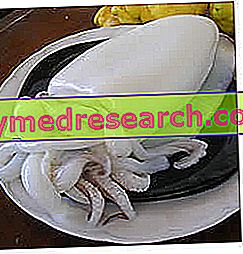Generality
Cuttlefish are sea molluscs that boast a considerable commercial and gastronomic value. They belong to the Decapod cephalopods and belong to the Sepiidae family, which in turn includes three different cuttlefish species : Metasepia, Sepia and Sepiella .
Cuttlefish colonize the whole planet; those of the Mediterranean and the Atlantic Ocean belong to the Specia Sepia officinalis.

It is not uncommon for small cuttlefish to be chosen for the purchase of cuttlefish for gastronomic reasons; in this case it is almost always species belonging to the genus Sepiella (eg S. inermis - Indian ocean).
The cuttlefish (Species S. officinalis, of which we will discuss in the following article) live almost all the year on depths of about 30-40m and, only in spring, they approach the coast to mate and lay their eggs (in clusters, black, globose and gelatinous).
The cuttlefish reach different sizes depending on the habitat they colonize; not surprisingly, large differences are observed between the cuttlefish of the Mediterranean sea (of which the smallest ones, which reach 25-35cm in length, belong to the Adriatic Sea) and the cuttlefish of the Atlantic ocean (where some specimens reach 90- 120cm in length). NB . The information concerning the MAXIMUM cuttlefish size varies according to the bibliographic sources but, what is certain, is that the cuttlefish of the Atlantic ocean can reach length and weight even higher than 300-400% compared to the Mediterranean sea specimens (in particular way compared to those of the Adriatic Sea).
Outside the water, on the back, the cuttlefish takes on a brown brindle color in black, while on the belly they appear clear, like pearly white, with green and pink reflections; in the water, the cuttlefish make use of an "active mimetic" system that seems to work through the visual memories of the animal (not by chance, the cuttlefishes are considered some of the most intelligent invertebrates of the planet). Dead cuttlefish lose their ability to camouflage and tend to fade to a pink-yellowish color, but they should not be confused with "spelled" cuttlefish, which are totally white.
The cuttlefish are oval in shape and morphologically are composed of two quite distinct segments: the body and the head. The cuttlefish body is surrounded by a lamellar fin that they use to move forward and to change direction, while inside it contains "the cuttlefish bone", the viscera, the gonads and eventually the eggs, and the "squid ink "(ink used as a defense mechanism). The head of the cuttlefish is very voluminous and hosts a brain of considerable size, wrapped in a structure of connective tissue; the eyes are positioned on the sides of the head while the mouth is located in the center and in the front (similar to a "beak" with a W shape). Around the oral cavity 10 legs are distributed with suction cups, 8 of which are tentacles while 2 serve as prehensile appendages necessary for predation. Cuttlefish feed on fish, crustaceans and other molluscs.
Giant Cuttlefish Salad
X Problems with video playback? Reload from YouTube Go to Video Page Go to Video Recipes Section Watch the video on youtubeCuriosity
Cuttlefish are molluscs of which different parts of the body are used. First of all, we specify that to carry out a "comfortable" cleaning of fresh cuttlefish it is VERY useful that they are placed in the freezer for a few hours. A semi-freezing determines the hardening of the flesh and ink, which allows the animal to be peeled and eviscerated easily without the bag with the black pigment being cut (or exploded) by staining anything. A recommended procedure for cleaning cuttlefish is as follows:
- Pre-freeze
- Elimination of the lamellar fin and skin
- Elimination of the eyes, mouth and cuttlefish bone
- Eventually, separate body and head
- On the back, where the bone was present, make a careful incision with the scissors and remove the viscera. TAKING CARE not to break the ink pouch
NB . I personally advise against removing the skin from the head; this is a particularly difficult and, ultimately, relatively necessary operation.
Cuttlefish is used for food, body, head, lamellar fin, female gonads, premature eggs (transparent and small like rice grains) and ink; the cuttlefish bone, instead, is a useful product as an integrator of amino acids and mineral salts in the breeding of some caged avian species.
The body and the head of the small cuttlefish are ideal for the production of skewers for grill or oven; the body of the large cuttlefish is more suitable for boiling (whole cooked and then sliced) for the preparation of warm or Catalan salads (but it is also excellent fried). The head with the relative tentacles and the lamellar fin of the large specimens are delicious if inserted between the ingredients of the seafood risotto, while the ink of cuttlefish, properly extracted from the fresh and placed in small containers (also storable in the freezer) is an ingredient excellent for: the production of black pasta, the composition of black sauces accompanying the first courses, and the composition of seafood risottos. The cuttlefish eggs and female gonads are a gourmet dish; it is a typically Venetian process and also allows these offal components to be exploited. The preparation of cuttlefish eggs is a simple and rapid boiling in hot water, at the end of which they are served with a little olive oil, fresh parsley and (for lovers) a teaspoon of mayonnaise.
How to choose Cuttlefish
Separate dimensions, for a successful cuttlefish-based preparation, the right choice of:
- Freshness-keeping
- Place of origin.
It is therefore useful to specify that freezing, in addition to greatly facilitating the cleaning of cuttlefish, determines an extremely useful maturation for tenderizing the flesh of adult specimens. This process is essential if the cuttlefish are prepared roasted, both on the grill and in the oven, and ESPECIALLY if the raw material is derived from NOSTRANA. The cuttlefish of the Mediterranean sea, in fact, boast organoleptic and gustatory characteristics far superior to the analogous ones coming from the Atlantic ocean, but their FRESH meats are remarkably consistent. Honestly, except for the risottos (in which they will be cut very thin), I ALWAYS recommend to freeze the cuttlefish of the Mediterranean sea (if fresh) before cooking; on the contrary, the large specimens of the Pacific Ocean (which are ALWAYS frozen or thawed) do not need any home treatment with cold (these cuttlefish are therefore more practical, cheaper, but certainly less tasty).
Cuttlefish freshness
Fresh or thawed cuttlefish appear visually in a completely different way. The fresh cuttlefish, generally, are completely intact and covered with ink (below which it is possible to observe a shiny skin, basically brown on the back and white on the belly); the very fresh catch even preserves the pearly nuances of the belly but it is however rare to buy cuttlefish practically alive, if not in a short chain. Fresh cuttlefish tend to fade over time and with heat, therefore, the acquired pallor is directly proportional to the time elapsed since the moment of their death. As far as thawed cuttlefish is concerned, the subject changes; those still to be cleaned are always faded, since cold treatment has a significant effect on the integrity of the skin, but not for this reason a quickly frozen cuttlefish is inferior in quality to another fresh one. On the contrary, as with all fish, crustaceans and cephalopod molluscs, a good frozen / frozen product is definitely advisable compared to a fresh ... "no longer very fresh".
| Nutritional composition per 100 grams of edible portion Sepia: | |||||||||||||||||||||||||||||||||||||||||||||||||||||||||||||||
 | |||||||||||||||||||||||||||||||||||||||||||||||||||||||||||||||
Nutritional values (per 100 g of edible portion) | |||||||||||||||||||||||||||||||||||||||||||||||||||||||||||||||
| |||||||||||||||||||||||||||||||||||||||||||||||||||||||||||||||
Cuttlefish undergo perishability very quickly; those that are not kept at temperatures around 0 ° C (better if in boxes with crushed ice) acquire a strong smell of sulfur (even if a microbiological examination could make them edible). Cuttlefish meat abounds in sulfur amino acids and, if poorly preserved, undergo the microbiological action of bacteria and / or its own enzymatic action, inevitably leading to the release of hydrogen sulphide (a molecule with the typical smell of "rotten eggs"). To learn more about the conservation of cuttlefish, read the dedicated article: How to preserve the fish and stop its degradation .
Nutritional characteristics
Cuttlefish has lean meats low in cholesterol; they are decidedly low-calorie dishes and their consumption portions easily reach 300g. Cuttlefish contain traces of sugars but the macronutrients that provide the greatest amount of energy are high biological value proteins (rich in sulfur amino acids).
From the point of view of mineral salts and vitamins, cuttlefish is not distinguished by any particular content.
Cuttlefish lend themselves considerably to low-calorie diets, since they have a good satiating power and a very low energy density; they are very useful even if contextualized in dietary regimes against dyslipidemia and type 2 diabetes mellitus, but they are not among the foods recommended in the diet for gout and hyperuricemia.
Cuttlefish contains a fair portion of connective tissue; this protein element (also present in the flesh of terrestrial animals but little in the fish proper and in bivalve / lamellibranch molluscs) increases with the age of the animal and is not as digestible as the muscular peptides. For this reason, for those suffering from digestive disorders, gastritis or gastric hypochlorhydria, we recommend: prefer small to medium sized cuttlefish, freeze them, cook them properly and do not reach excessive consumption portions, especially in conjunction with the evening meal.



